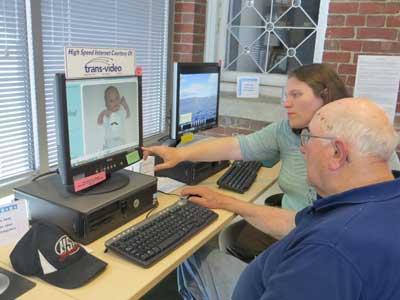This post was written by Tracy Staples, the program’s Internet Intern at the Brown Public Library in Northfield, VT.
I began working as an Internet Intern this past January after hearing that the program sorely needed an intern at the Brown Public Library in Northfield. After being introduced to the purposes of the Vermont Digital Economy Project, specifically the Digital Literacy Training with Internet Interns, I realized how well I would fit into the program. I have been a Peer Tutor at the Montpelier campus of the Community College of Vermont (CCV) for the last year and a half and I have worked extensively with adults who are unfamiliar with computers in general, let alone the Internet.
During my first few weeks as an intern, I met both Jack and Dalton. Jack is an accomplished coach for the Northfield Rifle Club, a driver for the local Meals on Wheels program, and an all-around dedicated member of the Northfield community. Jack first came in because he had recently acquired a used computer from the local bank and wanted to be comfortable using it. He wanted to know what the machine was capable of, as well as what he was capable of doing with it. Though he had some computer experience, he knew all too well that he didn’t know much.

Tracy shows Jack how to open an email attachment of a photo of his great-grandson
Always a few minutes early for our sessions, Jack has approached digital literacy with an openness and patience that surely reflect his years of responsive coaching. Though he doesn’t necessarily absorb new steps quickly, he needs no reminder that practice and repetition will reward him in the end. His steady determination and affable character always make his sessions a pleasant experience—for both of us.
In fact, it was Jack’s positive experience with me that led him to tell his friend Dalton about the new Internet Intern at Brown Public Library. A gregarious man with a mischievous streak, Dalton felt he was overdue for learning how to use the Internet, particularly email. His daughters had helped him create an email account, but he was never successful in accessing it on his own. With all of his adult children living in different parts of the state, he wished to have more contact with them and knew that email could make it possible. But with limited access to a computer and some fear of the unknown, he hadn’t known how to proceed.
Those first sessions together were focused primarily on Dalton slowing down and observing what he was doing. He struggled to use the mouse without jerky movements and often right-clicked unintentionally. Yet the more attention I gave to his mouse skills—and the screen tips that appeared once he learned how to hover over unfamiliar options—the smoother his progress became overall. As his mouse movements grew steadier, his ability to navigate the Internet and other programs increased, and his confidence grew.
After Dalton and I tackled those cursor basics, we moved on to his email. During our first few weeks, Dalton brought in a manila folder with all of the notes his daughters had made for him: the backside of an envelope had one daughter’s email address, two stapled sheets of printer paper held step-by-step directions for signing into Gmail with his password and username, and a piece of notebook paper listed sites he wanted to visit and learn to use. Essentially, Dalton was starting from scratch paper.
The first time Dalton successfully sent an email, he wondered aloud how long it would take his daughter to respond. He chuckled about his impatience before we worked on another message to one of his friends. After sending that second message, he was elated to see a new message in his inbox. His daughter had already written back! His joy was contagious as he opened a message filled with his daughter’s love for her father: she was excited to hear from him via email in the middle of her work day.
That was one of the first moments that reminded me just how powerful digital literacy is—a daughter and a father, basking in the love they have for one another, thanks to two emails of less than three sentences each. She knew what it took for him to write to her, and he knew that she had taken an extra moment in her hectic day to tell him how much she loved him.
Though he still needs the occasional reminder of where to compose a new email, Dalton no longer brings in his manila folder to our sessions. He is well beyond trying to remember his password and is now able to share just a little more of his affection with his loved ones through his playful, if brief, emails. And because he feels so much more comfortable sitting at a computer these days, he has recently become a student in an online Universal Class through the Vermont Department of Libraries—a venture to which he brings great enthusiasm, now that he is no longer battling with Internet anxiety.
As for Jack, at his most recent visit, I showed him how to open a picture attached to an email message. While Jack feels that his wife is sometimes more capable with email, he noted that enlarging the image had stumped them both. Yet it was important to Jack that he be able to clearly see the attachment: his month-old great-grandson was in that little thumbnail image.
When I showed Jack how to download it and zoom in, he was in awe. He practiced opening the email, downloading the image, zooming in—and doing it all over again. He then turned to me, smiling, and said, “Wait ‘til I show my wife this. This is exactly what I’m going to do as soon as I get home. Now we can see what he looks like!”
I smiled back, confident that Jack would be able to do just that.
